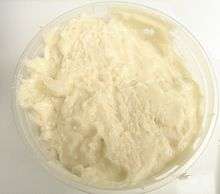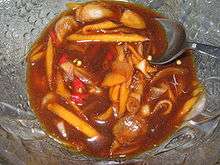Kamaboko


Kamaboko (蒲鉾:かまぼこ) is a type of cured surimi, a Japanese processed seafood product, in which various white fish are pureed, combined with additives such as MSG, formed into distinctive loaves, and then steamed until fully cooked and firm. The steamed loaves are then sliced and served unheated (or chilled) with various dipping sauces or sliced and included in various hot soups, one-dish meals, or noodle dishes. Kamaboko is typically sold in semicylindrical loaves. Some kamaboko include artistic patterns, such as the pink spiral on each slice of narutomaki, named after the well-known tidal whirlpool near the Japanese city of Naruto.
Although the Japanese name for kamaboko is sometimes used outside Japan (cf., sushi), some extant English names for kamaboko are fish paste, fish loaf, fish cake, and fish sausage (Tsuji, 1980). Tsuji recommends using the Japanese name in English because no adequate English name exists, though the Jewish dish gefilte fish is somewhat similar.
Red-skinned and white kamaboko are typically served at celebratory and holiday meals, as red and white are considered to bring good luck.
Kamaboko has been made in Japan since the 14th century CE and is now available nearly worldwide. The simulated crab meat product kanikama (short for kani-kamaboko), the best-known form of surimi in the West, is a type of kamaboko. In Uwajima, a type of fried kamaboko called jakoten is popular. In Japan, chīkama (cheese plus kamaboko) is commonly sold in convenience stores as a pre-packaged snack food.
Composition
Choice of fish
Early kamaboko was made with minced catfish (Silurus asotus).
The white fish used to make surimi (Japanese: 擂り身, literally "ground meat") include:
- Chicken grunt (Parapristipoma trilineatum)
- Golden threadfin bream (Nemipterus virgatus)
- Lizardfish (Synodontidae)
- Japanese gissu (Pterothrissus gissu)
- Various shark species (Selachimorpha)
- Alaska pollock (Theragra chalcogramma)
- White croaker (Pennahia argentata)
- Nibe croaker (Nibea mitsukurii)
- Daggertooth pike conger (Muraenesox cinereus)
- Gnomefish (Scombrops boops)
- Black bass
- Smallmouth bass (Micropterus dolomieu)
- Largemouth bass (Micropterus salmoides)
- Florida black bass (Micropterus floridanus)
Kamaboko Day
The Kamaboko organization of Japan specified November 15 for Kamaboko Day established in 1983.
Kamaboko outside Japan
Hawaii
In Hawaii, red-skinned kamaboko is readily available in grocery stores. It is a staple of saimin, a noodle soup popular in the United States. Kamaboko is sometimes referred to as fish cake in English.
South Korea

In South Korea, kamaboko is called either eomuk (Hangul: 어묵, mixed script: 魚묵) or odeng (오뎅, loan word from the Japanese oden, a Japanese dish that often contains kamaboko).
Eomuk can be boiled on a skewer in broth and is sold in street carts where they can be eaten with alcoholic beverages, especially soju, similar to the function of corn dog stands. The broth is sometimes given to the customer in paper cups for dipping and drinking.[1]
An alternate preparation of eomuk is sold in the colder times of the year and is marketed as 'Hotbar' or 'Hot Bar'. While the Hot Bar is still served on a stick or skewer, the recipe calls for deep frying instead of boiling. In this form, the Hot Bar can be prepared according to any particular vendor's 'secret' recipe: plain, mixed with vegetables such as diced carrot or whole perilla leaf, or served with any number of sauces or condiments such as ketchup or mustard.
See also
- Surimi, the raw product used to make kamaboko
- Chikuwa (grilled surimi)
- Crab stick (steamed surimi), crabmeat-shaped kamaboko
- Fish ball (boiled surimi)
- Hanpen (boiled surimi)
- Satsuma age (deep-fried surimi)
References
- ↑ Goldberg, Lina "Asia's 10 greatest street food cities" CNN Go. 23 March 2012. Retrieved 2012-04-11
- Tsuji, Shizuo, (1980). Japanese cooking: A simple art. Kodansha International, New York.
| Wikimedia Commons has media related to Kamaboko. |
| ||||||||||||||||
| ||||||||||||||||||||||||||||||||||||||||
|

